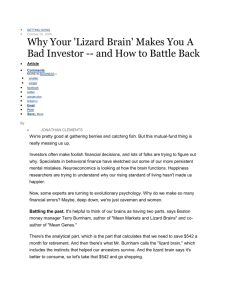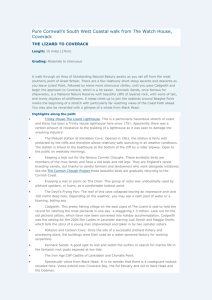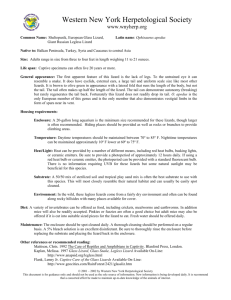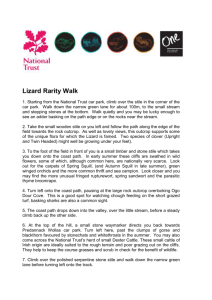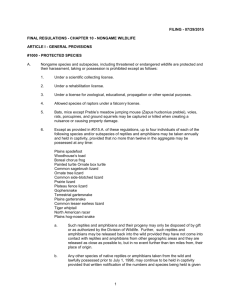Terry Burnham’s MEAN MARKETS An economist’s biological research
advertisement
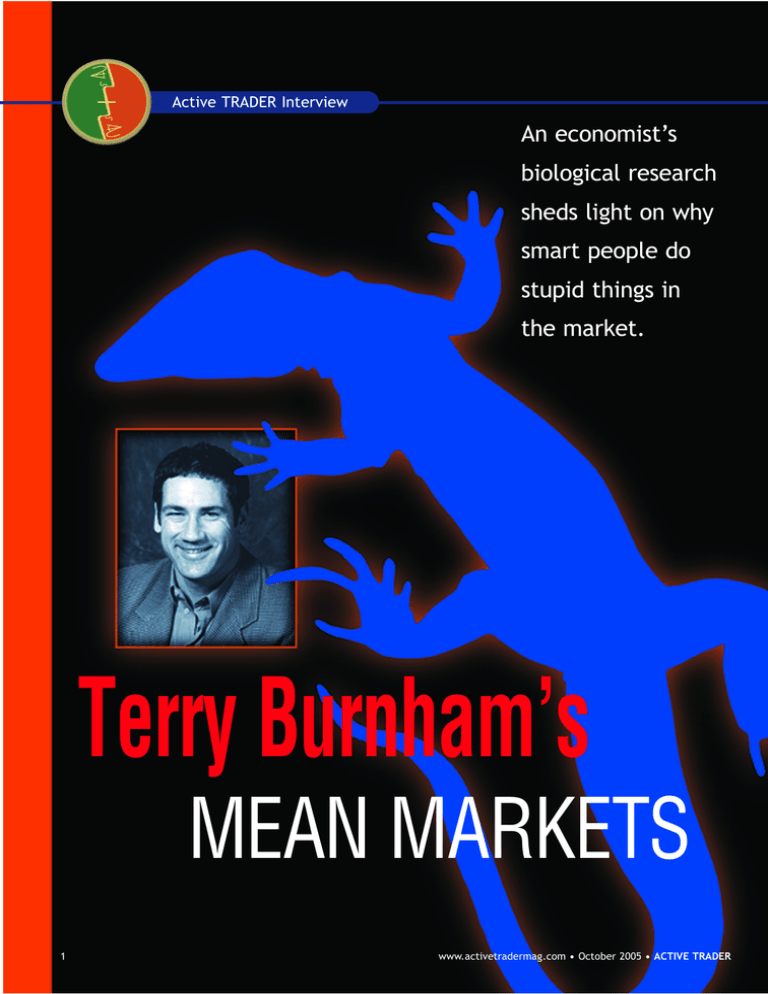
Active TRADER Interview An economist’s biological research sheds light on why smart people do stupid things in the market. Terry Burnham’s MEAN MARKETS 1 www.activetradermag.com • October 2005 • ACTIVE TRADER BY MARK ETZKORN T he next time you bail out of a losing long position just before the market bottoms, buy a “hot” stock that’s already been news for weeks, or refuse to take a small loss when the market is in the process of making it a big one, the following excuse might come in handy: The lizard made me do it. That, anyway, would be economist and author Terry Burnham’s explanation for why we tend to do foolish things when we trade and invest, even when we presumably know better. Burnham is the author of Mean Markets and Lizard Brains (John Wiley & Sons, 2005), a book that explores the biological underpinnings of our brain processes and how they manifest themselves in the markets — why, among other things, we sell in a panic when we should be buying and pile into overextended markets just as they’re about to collapse. In a nutshell, Burnham’s work in biological economics and behavioral finance explores the division of the brain between the conscious, cognitive, and rational part most of us believe we rely on, and the unconscious, reactive, emotional portion Burnham has dubbed the “lizard brain” and which, he argues, controls our actions more often than we think. Burnham’s first book (coauthored with Jay Phelan), Mean Genes: Taming Our Primal Instincts (Penguin, 2001), analyzed this dichotomy in the context of issues such as obesity and drug addiction. The basic premise is the lizard brain is essentially designed for survival in the Pleistocene Epoch — a stretch of prehistory from approximately 1.8 million years ago to 10,000 years ago when finding food and shelter was central to human survival. Like a trading system that has been optimized for market conditions that no longer exist, our brains keep issuing signals based on Pleistocene-era inputs, and these signals are often wholly inappropriate for the modern world. For example, epidemic obesity can be explained as the result of our cravings for high-fat foods that supplied the precious calories that were so difficult to come by in our Pleistocene past. Today, wealthy societies have virtually unlimited access to those calories (without the physical demands that used to be necessary to acquire them), but our brains are still programmed to eat these foods whenever and wherever we can get them because strength and survival depended on them in our distant past. Mean Markets explores this premise in the financial arena, analyzing how our lizard brains continue to ACTIVE TRADER • October 2005 • www.activetradermag.com hold sway over our actions as we attempt to extract profits from the markets. In short, because we are designed for a different type of world, our instincts are usually out of sync with financial opportunity: We buy when excited and sell when afraid. The lizard brain — an admirable product of evolution that helped our ancestors prosper in the primitive natural world — is, ironically, one of the things that prevents us from prospering in the modern financial world. Central to Mean Markets is the idea of “irrationality” as a science — a direct rebuttal to the traditional academic notions of rational decision making and efficient markets. The book lays out the concept of the lizard brain, neuroeconomics, and the manifestations of irrationality in the markets before tackling the economic landscape and assessing the bond, stock, and real estate markets in light of this information. Burnham discusses ways to profit from understanding our lizard brains, both in terms of shackling our own lizard impulses and keeping on the opposite side of others’ lizard brains. (Mean Markets also touches upon how bad most of us are at handling the basic calculations, such as simple probabilities, that lay a good foundation for analyzing markets.) There’s more to this than simply being a gardenvariety “contrarian” and trying to pick tops or bottoms. Contrarians who have tried to nail down the top of the oil market have been taking a beating for more than a year. Bearish contrarians who predicted the end to the 90s stock boom long before its eventual climax either missed out on gains or got hammered on short sales. Similarly, contrarians who thought the stock sell-off that began in 2000 was a minor aberration got killed buying dips as the market continued to fall and fall. (Whether the stock market ever completely “capitulated” is something Burnham addresses in both Mean Markets and this interview.) Burnham, 45, recently launched a new chapter in a multifaceted career, taking a position as director of economics at Acadian Asset Management, which manages approximately $20 billion using quantitative strategies. Prior to that he was a graduate student (earning a Ph.D. in business economics) and then faculty member at Harvard University for seven years, most recently teaching economics at the business school. Burnham earned a master’s in finance from MIT, a master’s in computer science from San Diego State University, and a bachelor’s degree in biophysics from the University of Michigan. He also served as a 2 It’s a hard game — the hardest game in the world, I think. You make your decisions, you make your play, and the market determines whether or not you’re correct. There’s a clear scorecard at the end of every day. I like that. tank driver in the Marines, worked at Goldman Sachs, and was CFO of a successful biotech start-up company called Progenics Pharmaceuticals. Burnham had an entrepreneurial bent from an early age (he jokingly refers to himself in his younger years as the “Alex Keaton” of his family) and, although he was a pre-med student as an undergraduate at the University of Michigan, he began to keep tabs on the markets. “One of my college buddies — who’s my accountant today — was interested in finance and he used to get the Wall Street Journal,” he says. “I just thought it was the weirdest paper in the world — no pictures and those two little columns. But by the time I was a junior, I was spending an hour to hour-and-a-half each day reading it.” Burnham found he loved the economics courses he took in his last year as an undergraduate and decided he didn’t want to go to medical school. But he didn’t enter the financial arena, either, at least not directly. He spent the next five years as a “computer guy,” working on military projects while getting his master’s degree in computer science at night. However, it was during that period he started trading. “I think my early [trades] were sort of ‘bad news buys,’” Burnham says. “I don’t know how great a strategy that is in general, but early on it worked for me. I bought Manville (a major asbestos producing company that eventually went bankrupt in the early 80s) stock one day around the time of some of its asbestos litigation. The next day it was No. 1 or No. 2 on the gainers list — up 13 percent. But when I sold it, I made all of $6 or so beyond commissions. And the bid-ask spread was huge — two-and-a-fourth to two-and-a-half. “But it was kind of exciting to have an opinion about something and make a call,” he adds. “In many areas of life, you have your opinion, the other guy has his opinion, and you can never be sure 3 who’s right. But in trading, I believe the market tells you the answer. I don’t agree when people say things like, ‘Oh, I made the right decision — the market was wrong.’ You make your decisions, you make your play, and you’re either correct or not, as determined by the market. That’s a kind of clarity you don’t find everywhere else. There’s a clear scorecard at the end of every day. I like that. It’s a hard game — the hardest game in the world, I think.” Burnham spoke with us from his home in Cambridge, Mass., where he lives with his wife, Barbara, and twoyear-old daughter, Charlotte. AT: How did you start exploring behavioral finance and the ideas in Mean Markets? TB: My research and my trading were really independent activities, and I didn’t realize they were linked until a few years ago. What I liked in what I’ve read about trading, and I’ve read many of the famous books — Reminiscences of a Stock Operator, Market Wizards, and so on — was the contrarian theme. That really stood out to me: The things you want to do are often wrong. As a trader, you’re often fighting your own emotions. And that was the lesson I took from my own trading — I had to have a discipline, I had to have my own approach. Everybody has their own game, but you’ve got to have a game. I found it very interesting that emotions and opportunity are out of sync. When the markets reopened after [the terrorist attacks in] September 2001, I remember thinking it was the end of the world — part of my brain felt that. But I was sophisticated enough to know that was a signal of a good buying opportunity. That idea about your emotions — that you would want to puke everything out right at the moment you should be buying — crystallized over my years of trading and studying. The other strain of my research was looking at how the human brain is designed and how it works. The two come together quite nicely in trading where, as in all activities, there’s a separation between the more rational, cognitive parts of your brain and the more emotional, instinctual, rapid-responding parts of your brain. There’s a dichotomy in all of us. In simplistic terms, there’s rational, thoughtful “you” that sits in the prefrontal cortex above the eyes, and then there’s this powerful, mysterious monster in the back of your brain. AT: Or as I like to call it, “The brain in charge” — the stupid part of me that seems to generally call the shots. TB: That’s true for everybody, and to an even greater degree than most people think. There have been really cool experiments on people with odd brain disorders, where they think they’re in control but you can tell they’re really not. I call that back part of the brain the “lizard brain,” because people know what it means right away — it’s the part of you that wants to eat the French fry, the part of you that wants to punch the guy who cuts you off on the road, and the part of you that wants to buy the stock at the top and sell it at the bottom. What’s really interesting — and I think it’s uniquely true in financial markets — is that you almost never want to let the lizard brain take control. AT: How do you go about doing that? Because one thing you pointed out in the book was the ability of the cognitive part of the brain to cover the lizard brain’s tracks. A person can make a lizard-brain decision, but the rational brain will make up retroactive excuses or explanations for it. So, even if you think you’re on guard for destructive behavior, it might be that your rational brain is really aiding and abetting your lizard brain. You might think you have www.activetradermag.com • October 2005 • ACTIVE TRADER the lizard tamed when you really don’t. TB: That’s right. We’re built to be strangers to ourselves. Even for activities that are almost entirely motivated by the lizard brain, we make up stories for them after the fact. I have a cheesy acronym: WIN. “W” is for Wake up that the back of the brain is in control. “I” is to investigate the nature of the lizard brain. And “N” is to neutralize the lizard brain. In terms of neutralizing the lizard brain in the markets, it’s not that different from grocery shopping: You know if you bring the junk food home it’s really tough not to eat it. So the way to neutralize your bad impulses — the way to win — is to align your world in a way that prevents the lizard brain from breaking out and doing bad things. If you were to think about two strategies for dealing with the junk food problem, the first is to buy the junk food but have the strength not to eat it — that is, willpower. The second strategy is figure out how not to get the junk food in your house. I’m completely of the mindset that the way to win is the second way — don’t allow yourself to be in a situation where temptation can overcome you. So construct you world accordingly. AT: Does that simply amount to having disciplined trading rules? TB: It’s different for different people. Everyone’s unique, but it comes down to not enabling your weaknesses, whatever they are. For me, if I watch a market for 10 minutes, I want to trade it. It doesn’t matter what it is — it could be Kazakhstan’s bond market. I’ve had to learn I need to not be able to make a lowcost trade. Now I have all my money in a fullservice brokerage account. So even though I might get excited and think I want to trade, the costs are so high now that it really slows me down. Some people have [sufficient] willpower. I have a buddy who runs a portfolio, and he has no problem. He has trading rules written out in various programs with all the various contingencies set up, and that works for him. Even though he has the ability to intervene, he doesn’t. So for him, having pre-set programs works well for him. For me, it wouldn’t — I’d just break right through them. If you’re an active trader, you need the ability to trade, so you have to be crafty with your own situation to figure out what other areas you mess up consistently and how to stop yourself from doing it. AT: Even before trade execution comes into the picture, though, doesn’t it seem like it might be a bigger challenge to take your lizard brain out of the research or analysis process, so you don’t fool yourself into thinking a certain pattern or strategy is promising by overlooking its flaws or seeing a benefit that isn’t really there? TB: I think you’re right. There are a couple of comments that come up a lot when I give talks about this. One is, “Hey, my hunches are often right.” I was giving a talk recently and this portfolio manager came up to me afterward and said, “I only want to get rid of the bad lizard brain ideas — I want to keep the good ones.” I asked, “Do you keep any kind of systematic records of your trading and figure out which [ideas] were the good ones and which were the bad ones?” He said no. I said, “Well, you have no idea whether you’re systematically right or wrong, then.” So at a minimum, you have to become a student of yourself. It’s not surprising to sophisticated traders, but you have to study yourself as you would another person. What’s interesting, though, is if you’re playing baseball the opponent is the other team. When you’re trading, the opponent is you. In baseball, as a hitter you might study what a certain pitcher tends to do on 2-and-2 counts. It’s important as a trader to know yourself just as well. In terms of figuring out whether your lizard brain is good or bad, or when it’s good or bad, and what the problems are, I think it really pays to be a student of your own trading and to be meticulous about it. AT: Did you maintain any kind of trade log or diary? TB: What I did was make sure that I had all my trades entered in real time. I didn’t do that initially, but by year two or three of my trading I had everything in a financial software program, and I was just ruthless about looking at it and iden- ACTIVE TRADER • October 2005 • www.activetradermag.com tifying what I’d done well and what I’d done poorly. I learned if you could wire up a machine to my lizard brain and do the opposite, you’d be a billionaire. I’ve had a pretty good track record, but it’s actually been despite my emotional side. My overall macro views have tended to be pretty good. My lizard brain has cost me a huge amount. I don’t feel bad about that because it’s true for everybody. In the early days of behavioral finance they used to conduct macro studies of how people were wrong — for example, in 1980 no one had any money invested in stocks right before the market went up by a factor of 10. But in the past few years there have been new papers published that look systematically at individuals’ trading records, and the answer is exactly what these [broader] anecdotes imply. One study analyzed paired trades at a large discount brokerage; they looked at situations where a person sold one stock and then bought another in a day or so. The stocks the people sold outperformed the ones they bought by an average of 330 basis points a year — that’s just huge. Other studies I’ve seen show the average stock investor didn’t make any money from 1982 until 1997, even though the Dow had gone from under 1,000 to over 7,000. The lizard brain’s impact, through emotional trading, is enough — even in the context of a huge trend — to erode all of your gains if you’re not savvy about it. AT: Do you have any opinion on whether certain analysis or trading approaches are especially risky in terms of lizardbrain traps? TB: My pet issue is current price data. Seeing real-time data is very dangerous, I think. AT: When you were trading more actively, what kind of techniques or approaches did you use? What markets did you trade? TB: Mostly U.S. stocks. [I made] some purchases of bonds and gold-mining companies. I have an excellent overall track record, but again, it’s despite my lizard flaws. I was bullish on stocks for almost 20 years — 1982 to 1999. I’ve been skeptical and bearish on stocks for most of the time since then. 4 5 This graphic from Terry Burnham’s book Mean Markets and Lizard Brains shows that although inflows into equity mutual funds are down from their bull market peak, they’ve rebounded since 2002’s net outflow. $350 $300 $250 $200 $150 $100 $50 2003 2002 2001 2000 1999 1998 1997 1996 1995 1994 1993 1992 1991 1990 1989 1988 1987 1986 -$50 1985 $0 1984 AT: In your book you write about the current states of a few markets, including real estate and stocks, and how our brains have been trained by the fairly recent past to look for patterns that aren’t going to be there to reward us in the future. You seemed to be talking more about people looking for continued appreciation. Isn’t there also the chance that, similar to the situation after the 70s, there’s going to be a lot of people who will miss out on the next bull market in stocks because of what they went through after the collapse in 2000? TB: Most authors who have attempted to convert this research on human nature into trading strategies generally stop at micro tactics — don’t trade emotionally, don’t average losers, etc. I included those kinds of things in my book, and I think they’re good ideas. But I also thought it was important — in part because I was curious, too — to see where we were in the macro picture. We know on the micro level we’re always going to be pushed in the wrong direction by the lizard brain and we know we shouldn’t trade emotionally — we should be very careful, study ourselves, know our enemy is within us. On the macro level, looking at the world and seeing where the risk points are is a much more artistic, delicate thing. I’m much less likely to be right about those conclusions than about the first ones. I’m 100-percent sure no one should trade emotionally. I don’t know whether people should own stocks right now. I’m FIGURE 1 EQUITY MUTUAL FUND MONEY FLOWS Net new cash to equity funds ($ billions) I’ve been on the right side of most major market moves in all my trading, but my execution has been terrible, in that I suffer from the same lizard emotions as everyone else. For example, I was short the big tech stocks from early 2000 to the beginning of the Iraq War (in 2003) — perfect analysis. I made about a 50-percent return in that time frame — which is much better than losing money, but I feel like a huge opportunity passed and I was able only to take one deep drink instead of filling my wagon for life. When I look at my trades, I tended to be the most short at the bottom of down phases and I got squeezed out on the sharp countertrend rallies. So Mean Markets and Lizard Brains comes in part from me trying to understand my own lizard-brain moves that have cost me a lot of money. Years Source: Investment Company Institute, 2004 Fact Book, Table 13 pretty sure they should own fewer stocks than they think they should, but I’m not sure they should own zero. So, one question is, it is true that when stocks bottom, will people be out of sync? And I think the answer is yes, the vast majority of people will be out of sync because of human nature. Another question is, when is the right time to get into stocks? That’s related to whether that bottoming cycle in the stock market has run its course. In every area of the book I try to combine fundamental analysis with the psychological/emotional analysis. From a fundamental perspective, stocks look about fairly valued to me — they look a little rich, but not crazily overvalued. But I end up being a little negative about stocks — because most people aren’t negative yet. People have not fled equities yet. A figure in the book (see Figure 1) shows money flows into equity mutual funds went to zero and now they’ve rebounded again. People have just been piling cash into equities for the past 15 years. As a percentage, they’re still the biggest financial asset people own, and I just can’t find any examples in the history of the world where the most popular asset has been profitable. It’s a coin flip for me based on fundamentals — P/E, price-to-book ratio, that kind of thing — but I just find it impossible that everybody can be right about stocks. I’m not a perfect student of international markets and so forth, but I’d be happy to see a single case where the most popular investment turned out to be extremely profitable. I don’t have all the data, but I think the answer is no. AT: Is it possible to harness the lizard brain and use it positively, rather than neutralize it? TB: Well, there are those “freak” traders — I talk about Paul Tudor Jones in the book — who seem to become great traders. There is some evidence the lizard brain does get better. You know, why is Peyton Manning going to be a better quarterback than he was three years ago? His arm is probably weaker, but his brain is probably stronger, and it’s probably his lizard brain. So there is evidence the back of the brain gets better at pattern recognition. The kind of stuff really good active traders do well does involve a sort of non-cognitive realization — “Oh, this is how it ‘felt’ last time.” So I think you can train the lizard brain. The other thing is, if you can win in that battle to constrain your own lizard brain, you have the opportunity to be on the other side of everyone else’s lizard www.activetradermag.com • October 2005 • ACTIVE TRADER I learned if you could wire up a machine to my lizard brain and do the opposite, you’d be a billionaire. I’ve had a pretty good track record, but it’s actually been despite my emotional side. brain. What we try to do as a firm at Acadian and what I’ve tried to do as an individual investor for the past 20 years or so is not only neutralize the lizard brain, but also figure out methodologies to be systematically on the other side of everybody else’s lizard brain. The central question is, how do you avoid that 330 basis-point leakage the average person has? That’s the difference between caviar and cat food right there. A little compound interest, a little 20- or 30-year time period, and you’re either poor or you’re rich. AT: Have you found that professional traders were more likely than academics to agree with your findings? I think a lot of people who have been in the markets for a long time would say to themselves, “No kidding, markets are irrational — I’ve had to deal with that every day for years.” TB: I differentiate individual irrationality from market irrationality. Academics are the only people who believe in rationality for people. AT: It’s difficult to understand that. TB: I do. It’s a longer story, but it’s like an old Bazooka Joe comic where the guy asks his friend to help him find his car keys. They look around for a while and the friend asks, “Where did you lose them?” and he says, “Oh, I lost them somewhere down the street.” The friend asks, “So why are we looking here?” and the guy says, “Well, the light’s better here.” The same thing goes on in academics. In short, it’s easy to model rationality. Look at all those papers filled with math: Even though it looks complicated, that’s the easy version. When you try to model irrationality, it gets very difficult. I would say 90 percent of economists still think individuals are rational and 99 percent of finance professors still think markets are rational. Most people are still mainstream. Then there’s a huge group of behavioral economists — Danny Kahneman and my advisor Vernon Smith shared the Nobel Prize — who have become extremely powerful. Finally, there’s a tiny, tiny group of 10 to 20 people or so who are really interested in the biological foundation of that behavior. All the neuroeconomics we’ve been reading about are really showing the biological source of what we think of as irrational behavior. So I think the trend is definitely very positive; it just takes a very long time. AT: One thing I think is interesting is the way some people try to analyze markets or approach trading in the context of some kind of “natural” order or rhythm. They present that kind of framework as something very compelling, but it doesn’t seem to make sense because markets seem very unnatural — which is something you pointed out in your book. TB: It would be odd to me if there were exact continuum between non-human and human behaviors. Our brains were built for a different world. I make a point about zoo animals (how they behave differently in captivity vs. the wild). We’re “zoo primates.” It’s not obvious to me there would be the same patterns of behavior if you had animals in their natural setting — human or non-human. A lot of these bizarre outcomes, where instincts don’t work in our favor, are a product of us living in an unnatural environment. For me it just boils down to a couple of points. The first is that you have a big part of your brain — the lizard brain — that’s working sort of outside your control, and in the financial markets it’s not working for you. In some ways, that’s where standard contrarian logic sort of stops. ACTIVE TRADER • October 2005 • www.activetradermag.com What I think is novel about recent advances is that there’s a logic to this behavior. So rather than just saying, “I’m my enemy, I have to do the opposite of what I want to do,” you instead try to understand why the back of the brain is built the way it is — that, to me, is the advance of the past 10 to 15 years. The lizard brain is not your friend, but there’s a logic to the lizard brain — that’s the real advantage. If you can figure that out, it really helps you achieve your goals. AT: It seems like it’s one thing to understand it, and another thing to be able to capitalize on it. I know I’ve gone against markets precisely because everybody had been jumping on them and I thought they were overdone. So there I am, presumably doing the right thing by overriding my lizard brain, but still going against a market too early. TB: It’s very tough. Have you heard the Isaac Newton bubble stories? He made money in the South Sea Bubble, thought it was crazy and got out. It kept going up for another year. And just like all the things we’ve seen in our own time, it was crazy and there was all kinds of press. Eventually he got back in and sort of doubled down and lost a ton of money. Some people get out at the right time when a market is high and going higher, but it’s a very difficult thing. The housing market is a perfect example of this now. I think it’s likely to have below-average gains for the next decade or so. It could have above-average gains for who knows how long, but I still don’t want to play that game. If you’re mom and pop and you think you’re going to put your life savings into a house, I think you’re playing the wrong game. But if you’re a pro, I think you can take your shot. In any overheated market, I think if you believe you can play a certain game, it’s OK — as long as you know that’s the game you’re playing: “I’m buying something overpriced and I’m going to sell it even more overpriced, and I know I’m playing a pro’s pro game. I’m playing against other tough people — like against other card sharks in Vegas — and I think I can take ‘em down.” If you buy value, you can wait. If you buy bubble, you have to sell before the bubble pops. © October 2005, Active Trader Magazine 6
